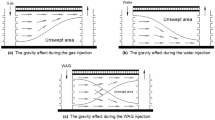Abstract
This paper presents the results of numerical simulation of the injection of liquid sulfur dioxide into a porous reservoir accompanied by the formation of sulfur dioxide gas hydrate. The case is considered where the reservoir is initially saturated with methane and water and has a finite length and an impermeable outer boundary. It is shown that in the initial stage, the replacement of methane from the reservoir can occur with or without the formation of methane gas hydrate, depending on the permeability of the porous medium and pressure. It is found that over time, the thermodynamic conditions in the region of methane filtration become close to the formation conditions of methane gas hydrate.
Similar content being viewed by others
References
Qi Li, Xiaochun Li, Ning Wei, and Zhiming Fang, “Possibilities and Potentials of Geological Co-Storage CO2 and SO2 in China,” Energ. Proc. 4, 6015–6020 (2011).
A. Anshits, N. Kirik, and B. Shibistov, “Possibilities of SO2 Storage in Geological Strata of Permafrost Terrain,” Adv. Geol. Storage Carbon Dioxide 65, 93–102 (2006).
A. G. Anshits, N. P. Kirik, and S. N. Vereshchagin, “Environmental and Engineering Geology: Underground Disposal As a Possibility of Complete Utilization of Sulfur Dioxide,” Inzh. Ekol., No. 3, 3–19 (2009).
V. A. Istomin and V. S. Yakushev, Gas Hydrates in Nature (Nedra, Moscow, 1992) [in Russian].
E. M. Chuvilin and O. M. Guryeva, “The Role of Hydrate Formation Processes in Industrial CO2 Sequestration in Permafrost Area,” Petroleum Abstr. 55 (48), 96 (2015).
J. F. Wright, M. M. Cote, and S. R. Dallimore, “Overview of Regional Opportunities for Geological Sequestration of CO2 As Gas Hydrate in Canada,” in Proc. of the 6th Int. Conf. on Gas Hydrates, Vancouver, Canada, July 6–8, 2008 (Univ. British Colambia Library, Vancouver, 2008).
E. M. Chuvilin and O. M. Guryeva, “The Role of Hydrate Formation Processes in Industrial CO2 Sequestration in Permafrost Area,” in Proc. of the 7th Int. Conf. on Gas Hydrates, Edinburgh, Great Britain, July 17–21, 2011 (Curran Associates, Red Hook, 2011), p. 220.
E. M. Chuvilin and O. M. Guryeva, “Carbon Dioxide Gas Hydrates Accumulation in Freezing and Frozen Sediments,” in Proc. of the 6th Int. Conf. on Gas Hydrates, Vancouver, Canada, July 6–8, 2008 (Univ. British Colambia Library, Vancouver, 2008), p. 5469.
P. Jadhawar, A. H. Mohammadi, J. Yang, and B. Tohidi, “Subsurface Carbon Dioxide Storage through Clathrate Hydrate Formation,” Adv. Geol. Storage Carbon Dioxide 65, 111–126 (2006).
A. D. Duchkov, L. S. Sokolova, D. E. Ayunov, and M. E. Permyakov, “Assessment of the Potential of West Siberian Permafrost for Carbon Dioxide Storage,” Kriosfera Zemli 13 (4), 62–68 (2009).
E. M. Chuvilin and O. M. Guryeva, “Experimental Study of CO2 Hydrate Formation in the Pore Space of Frozen and Permafrost Rocks,” Kriosfera Zemli 13 (3), 70–79 (2009).
V. E. Dontsov, A. A. Chernov, and E. V. Dontsov, “Shock Waves and the Formation of Carbon Dioxide Hydrate at an Increased Initial Pressure in the Gas-Liquid Medium,” Teplofiz. Aeromekh. 14 (1), 23–39 (2007) [Thermophys. Aeromech. 14 (1), 21–35 (2007).
V. E. Dontsov and A. A. Chernov, “Dissolution and Hydrate Formation behind a Shock Wave in a Gas-Liquid Mixture,” Dokl. Akad. Nauk 425 (6), 764–768 (2009).
A. A. Chernov, A. A. Pil’nik, D. S. Elistratov, et al., “New Hydrate Formation Methods in a Liquid-Gas Medium,” Sci. Rep. No. 7, 408–409 (2017).
G. G. Tsypkin, “Hydrate Formation in Injection of Liquid Dioxide Carbon into a Reservoir Saturated with Methane and Water,” Izv. Ross. Akad. Nauk, Mekh. Zhidk. Gaza, 51 (5), 99–107 (2016) [Fluid Dyn 51 (5), 672?679 (2016)].
M. K. Khasanov, “Hydrate Formation Regimes during Carbon Dioxide Injection into a Porous Medium Saturated with Methane and Water,” Inzh-Fiz. Zh. 91 (4), 922–931 (2018).
M. K. Khasanov, “The Formation of the Region of the Mixture of Hydrates of Carbon Dioxide and Methane during Injection of Liquid Carbon Dioxide into a Formation Saturated with Methane and Water,” Prikl. Mat. Mekh., No. 6, 789–793 (2018).
M. K. Khasanov, “Injection of Carbon Dioxide into a Reservoir Saturated with Methane and Water,” Prikl. Mekh. Tetkh. Fiz. 58 (4), 95–107 (2017) [J. Appl. Mech. Tech. Phys. 58 (4), 652–663 (2017)].
A. A. Samarskii and P. N. Vabishchevich, Computational Heat Transfer (Editorial URSS, Moscow, 2003) [in Russian].
Author information
Authors and Affiliations
Corresponding author
Additional information
This work was supported by the Russian Foundation for Basic Research (Grant No. 19-08-00967).
Original Russian Text © M.K. Khasanov, M.V. Stolpovskii.
__________
Translated from Prikladnaya Mekhanika i Tekhnicheskaya Fizika, Vol. 61, No. 3, pp. 90–99, May–June, 2020.
Rights and permissions
About this article
Cite this article
Khasanov, M.K., Stolpovskii, M.V. Numerical Study of the Injection of Liquid Sulfur Dioxide into a Porous Reservoir Saturated with Methane and Water. J Appl Mech Tech Phy 61, 391–399 (2020). https://doi.org/10.1134/S0021894420030104
Received:
Revised:
Accepted:
Published:
Issue Date:
DOI: https://doi.org/10.1134/S0021894420030104




